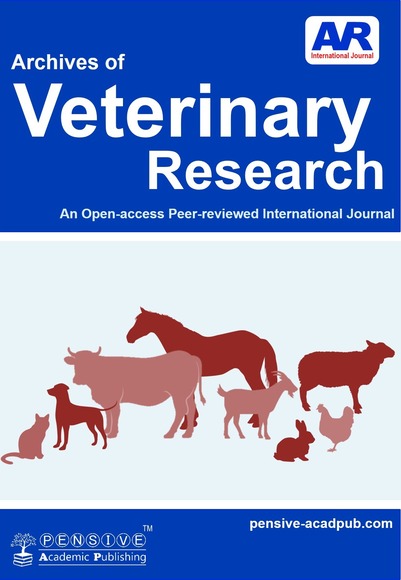Molecular detection and antibiogram profile of Pasteurella multocida isolated from backyard poultry and turkeys from Puducherry, India
PCR-based detection and antimicrobial susceptibility testing of Pasteurella multocida isolates
DOI:
https://doi.org/10.70964/avr.4Keywords:
Fowl cholera, Bipolar organism, Pasteurella multocida, KMT gene, AntibiogramAbstract
Fowl cholera, caused by Pasteurella multocida serogroup A, is a highly infectious and economically significant disease affecting commercial and backyard poultry, including turkeys. In this comprehensive study, we examined ten birds (chickens and turkeys) with the history of high mortality and exhibited clinical signs such as nasal discharges, anorexia, and respiratory distress. During post-mortem examinations, multifocal necrosis of the liver, edematous lungs and pericarditis were observed. Microscopic examinations of Leishman-stained heart blood smears and liver impression smears revealed the presence of bipolar organisms. The tissue samples were subjected to bacterial isolation and identification using conventional biochemical tests, detecting five P. multocida isolates from chickens and five from turkeys. All ten isolates were further confirmed through Polymerase Chain Reaction (PCR) targeting the KMT gene, a species-specific primer for P. multocida, ensuring the accuracy of our findings. The antibiogram indicated that the isolates were susceptible to Enrofloxacin (100%), Tetracycline (80%), Gentamicin (60%), and Ciprofloxacin (40%), while all the isolates were resistant to Penicillin G (100%) and most were resistant to Sulphamethoxazole (90%). This study indicates that fowl cholera was prevalent in backyard chickens and turkeys in the Puducherry region, so backyard poultry farmers are encouraged to implement regular vaccination practices against fowl cholera.
References
1. Department of Animal Husbandry and Dairying (DAHD), 20th Livestock Census. https://vikaspedia.in/agriculture/agri-directory/reports-and-policy-briefs/20th-livestock-census. Accessed May 13, 2022.
2. Ayala, A.J., Yabsley, M.J. and Hernandez, S.M. 2020. A Review of pathogen transmission at the backyard chicken-wild bird interface. Frontiers in Veterinary Science, 7: 53. https://doi.org/10.3389/fvets.2020.539925
3. Panna, S.N., Nazir, K.N.H., Rahman, M.B., Ahamed, S., Saroare, M.G. and Chakma, S. 2015. Isolation and molecular detection of Pasteurella multocida Type A from naturally infected chickens and their histopathological evaluation in artificially infected chickens in Bangladesh. Journal of Advances in Veterinary and Animal Research, 2: 338-345. https://doi.org/10.5455/javar.2015.b104
4. Mohamed, M.A., Mohamed, M.W., Ahmed, A.I., Ibrahim, A.A. and Ahmed, M.S. 2012. Pasteurella multocida in backyard chickens in Upper Egypt: incidence with polymerase chain reaction analysis for capsule type, virulence in chicken embryos and antimicrobial resistance. Veterinaria Italiana, 48: 77-86.
5. Mehmood, M.D., Qazi, M.H., Muhammad, K., Shahid, M., Akram, M. and Ali, M.A. 2016. Isolation and molecular characterization of Pasteurella multocida from commercial layer flocks suffering from respiratory syndromes. Journal of Animal and Plant Sciences, 26.
6. Blakey, J. Crispo, M., Bickford, A. and Stoute S. 2019. Fowl cholera and acute heart rupture in a backyard turkey. Journal of Veterinary Diagnostic Investigation, 31: 390-394. https://doi.org/10.1177/1040638718823850
7. Carter, G.R. 1955. Studies on Pasteurella multocida. I.A haemagglutination test for the identification of serological types. American Journal of Veterinary Research, 16: 481-484.
8. Harper, M., Boyce, J. D. and Adler, B. 2006. Pasteurella multocida pathogenesis: 125 years after Pasteur. FEMS Microbiology Letters, 265: 1-10. https://doi.org/10.1111/j.1574-6968.2006.00442.x
9. Heddleston, K.L., Gallagher, J.E. and Rebers, P. 1972. Fowl cholera: gel diffusion precipitation test for serotyping Pasteurella multocida from avian species. Avian Diseases, 16: 925-936. https://doi.org/10.2307/1588773
10. Cowan, S.T. 1974. Cowan and Steel's Manual for the Identification of Medical Bacteria. 2nd Edition, Cambridge University Press, Cambridge, 67-83.
11. Venkatvasan, R.; Antony, P.X.; Mukhopadhyay, H.K.; Jayalakshmi, V.; Vivek Srinivas, V.M.; Thanislass, J.; Stephen, S. 2020. Characterization of methicillin-resistant Staphylococcus aureus from goats and their relationship to goat handlers using multi-locus sequence typing (MLST). Small Rumin. Res. 186, 106097. https://doi.org/10.1016/j.smallrumres.2020.106097
12. Townsend, K., Frost, A.J., Lee, C.W., Papadimitriou, J.M. and Dawkins, H.J. 1998. Development of PCR assays for species and type specific identification of Pasteurella multocida isolates. Journal of Clinical Microbiology, 36: 1096-1100 https://doi.org/10.1128/JCM.36.4.1096-1100.1998
13. Vivek Srinivas VM, Parthiban S, Mukhopadhyay HK and Antony PX (2014) Pasteurella multocida infection in Emu (Dromaius novaehollandiae), Indian Veterinary Journal 91(6): 9-12. https://doi.org/10.5281/zenodo.14178335
14. Bauer, A.W., Kirby, W.M., Sherris, J.C. and Turck, M. 1966. Antibiotic susceptibility testing by a standardized single disk method. American Journal of Clinicial Pathology, 45: 493-496 https://doi.org/10.1093/ajcp/45.4_ts.493
15. Clinical and Laboratory Standards Institute (CLSI). Performance Standards for Antimicrobial Susceptibility Testing. 2019. 24th Informational Supplement. M100-S24. Clinical and Laboratory Standards Institute, Wayne, PA, USA.
16. Chawak, M.M., Verma, K.C., Kataria, J.M. and Kamar, A.A. 2000. Characterization of indigenous isolates of avian Pasteurella multocida. Indian Journal of Comparative Microbiology Immunology and Infectious Diseases, 21: 111-114.
17. Cheesbrough, M. 2006. Biochemical tests to identify bacteria. District laboratory practice in tropical countries, Part 2. 2nd Edn., Cambridge University Press, UK, 7: 62-70.
18. Shivachandra, S.B., Kumar, A.A., Gautam, R., Singh, V.P., Saxena, M.K. and Srivastava, S.K. 2006. Identification of avian strains of Pasteurella multocida in India by conventional and PCR assays. Indian Veterinary Journal, 172: 561-564. https://doi.org/10.1016/j.tvjl.2005.05.007
19. Ievy, S., Khan, M. R. F., Islam, M. A. and Rahman, M. B. 2013. Isolation and identification of Pasteurella multocida from chicken for the preparation of oil-adjuvanted vaccine. Bangladesh. Journal of Veterinary Medicine, 2: 1-4. https://doi.org/10.3329/mh.v2i1.17253
20. Sarangi, L.N. and Panda, H.K. 2011. Antibiotic sensitivity of avian isolates of Pasteurella multocida. Indian Veterinary Journal, 88: 85-86.
21. Aye, P.P., Angrick, T.Y., Morishita, T.Y. and Harry, B.S. 2001. Prevalence and characteristics of Pasteurella multocida in commercial turkeys. Avian Diseases, 41: 182-190. https://doi.org/10.2307/1593026
Downloads
Published
How to Cite
Issue
Section
License
Copyright (c) 2024 © 2024 Pensive Academic Publishing. All rights reserved. | Archives of Veterinary Research

This work is licensed under a Creative Commons Attribution 4.0 International License.




